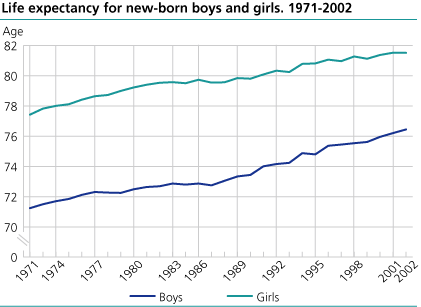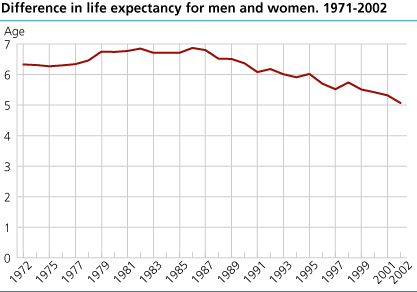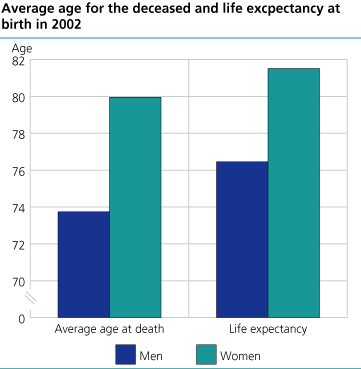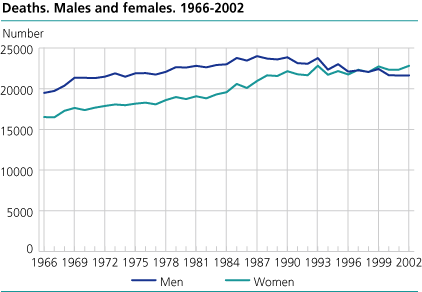Content
Published:
This is an archived release.
Men live longer
Men's life expectancy continues to increase. The difference in life expectancy between the sexes declines. In 2002, life expectancy at birth was 81.52 years for girls and 76.5 years for boys, a difference of 5.1 years.
For the fourth year in a row, life expectancy for men increased more than for women. From 2001 until 2002 the increase for men was 0.24 years, while there was no change for women. We have to go back to the 1960s to find less difference. This may for instance be seen in the connection with smoking habits. Fewer men smoke, while there has been little change among women.
Figures from 2001 show that in the Nordic countries, Swedish and Icelandic men live longer than the Norwegian ones, while the Finnish and Norwegian women live the longest. On average, Norwegians live two years longer than the Danes. In the world as a whole, the Japanese people were expected to live the longest - with a life expectancy of 78.07 years for men and 84.93 years for women.
The average age for people who died in Norway in 2002 was 76.93 years. For men the average age was 73.74 years, while it was 79.96 years for women. The average age for the deceased in 2002 was lower than that of life expectancy because of variations in the birth cohorts from previous years. There were especially few people in the age groups where people normally die, the age groups above 60-70 years.
Largest decline in infant mortality among boys
Infant mortality, which is deaths under one year of age per 1 000 live births, was 3.46 in 2002. This is the lowest figure ever registered in Norway.
Infant mortality for girls is normally lower than for boys, but in 2002 it was for the first time lowest for boys. This is most likely due to coincidences. Last year infant mortality for girls was 3.62 for girls and 3.32 for boys. The decrease in infant mortality is influencing the mortality rate as well as the life expectancy. The decline in infant mortality among boys is one reason why the mortality rate for boys declined more than for girls, and that life expectancy of men increased the most.
On average for the years 1998-2002 infant mortality was highest in Finmark, with 5.82, and lowest in Nord-Trøndelag, with 2.16. The country's average was in the same time period 3.78.
44 500 deaths in 2002
Approximately 44 500 people died in 2002, almost the same as in 2001. 22 800 women and 21 640 men died, 1 200 more women than men. Also during the years 1999-2001 more women than men died, while in all previous years the opposite has been the case. This is mainly due to changes in the population's age composition.
55 per cent of those who died in 2002 were older than 80 years. In Sogn og Fjorande and Møre og Romsdal the proportion of those over 80 years was almost 60 per cent, while it was 45 per cent in Finmark. On average for Norway, about 60 per cent of all who died in 2002 were women.
Tables:
- Table 1 Deaths and death rates 1961-2002
- Table 2 Death males and females, by age. Country. 2002
- Table 3 Death males, by age. Country. 2002
- Table 4 Death females, by age. Country. 2002
- Table 5 Deaths per 1 000 population. Standardized rates. County. 1949-1985
- Table 6 Age-specific death rates for males and females. 1971-2002
- Table 7 Expectation of life for males and females at selected ages. 1946-2002
- Table 8 Perinatal and infant mortality. 1956-2002
- Table 9 Infant mortality. County. 1966-2002
- Table 10 Life tables , 2002
- Table 11 Expectation of life for males and females at selected ages, by county. 1971-2000
Contact
-
Anders Sønstebø
E-mail: anders.sonstebo@ssb.no
tel.: (+47) 46 66 37 74
-
Magnus Haug
E-mail: magnus.haug@ssb.no
tel.: (+47) 40 81 14 91
-
Ane Margrete Tømmerås
E-mail: ane.tommeras@ssb.no
tel.: (+47) 91 99 29 62
-
Statistics Norway's Information Centre
E-mail: informasjon@ssb.no
tel.: (+47) 21 09 46 42
-
Oppdrag befolkningsstatistikk
E-mail: befolkning@ssb.no




